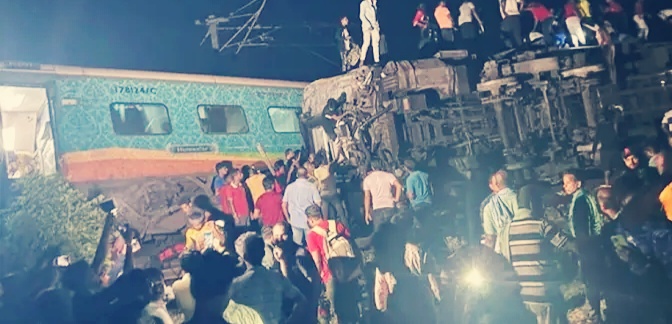Odisha train crash
Approximately 238 people were killed and more than 900 injured in the Odisha train crash in India, involving the Bengaluru-Howrah Superfast Express service, the Coromandel Express service and a scheduled goods train.
The Indian train crash is believed to have been caused by a signal fault, according to the country’s railway minister. It is likely that a “change in electronic interlocking” was responsible for the incident in Odisha, resulting in a deadly collision involving three trains. The minister, Ashwini Vaishnaw, stated that the cause and individuals responsible for the accident have been identified but provided no further details.
The Railway Board of India stated that there was “some kind of signalling interference” rather than a failure. A comprehensive report on the worst rail accident in India this century is expected to be released soon. The death toll has been revised to 275 after certain bodies were mistakenly counted twice. Among the 1,175 injured individuals who were taken to the hospital, 793 have been discharged, while some families are still searching for their missing loved ones.
In railway signalling, the electronic interlocking system is responsible for establishing routes for trains within a designated area, ensuring their safe movement along the tracks. In this particular crash, a passenger train collided with a stationary goods train and derailed after being incorrectly directed onto a loop track adjacent to the main line. The derailed carriages subsequently struck the rear carriages of a second passenger train traveling in the opposite direction.
Jaya Verma Sinha, a representative from India’s Railway Board, revealed during a press conference that both passenger trains approached a station in Balasore district with a green signal, indicating safety, just seconds apart from each other and at the correct speed of under 130 km/h (81 mph). The intended plan was for the passenger trains to pass each other on the main lines, but the Coromandel Express crashed into a freight train carrying iron ore on the loop line. This caused the engine and some coaches to lift over the heavy goods carriages. The freight train itself remained unaffected and did not derail.
Although Ms. Verma Sinha clarified that there were no issues with the electronic interlocking system, investigations have suggested the presence of “some kind of signalling interference” rather than a failure. The exact nature of this interference, such as whether it was manual, incidental, weather-related, or related to maintenance or wear and tear, will be determined in the ongoing inquiry.
An infrastructure expert, Partha Mukhopadhyay, expressed surprise at the failure, stating that it should not be possible for green signals to display on the main line if the track is set for the loop. Mr. Mukhopadhyay, associated with the Delhi-based think tank Centre for Policy Research, described the signal interlocking system as fail-safe and considered this level of failure to be highly unusual.
Prime Minister Narendra Modi visited the crash site on Saturday and pledged strict punishment for those found responsible. It is estimated that around 2,000 people were on board the two passenger trains involved in the collision: the Coromandel Express, traveling between Kolkata and Chennai, and the Howrah Superfast Express, traveling from Yesvantpur to Howrah. The incident occurred at approximately 19:00 (13:30 GMT) on Friday.
Pradeep Jena, an official from the Odisha state, reported that at least 187 bodies remained unidentified. The authorities have been posting pictures of the victims on government websites and will conduct DNA testing if necessary.

